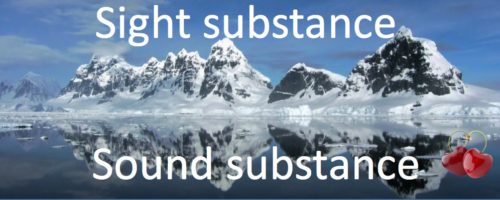Listening Cherry 29 – Two substances
There is one major prerequisite for becoming an effective user of a language. (Being a prerequisite means that it is an essential requirement before you can start doing anything meaningful.) This prerequisite is ‘substance mastery’. By this I mean mastery of the substances of both writing and speech, the ability to form (in writing and speaking), and to perceive (in reading and listening) the words that you and other people write or say. Substance mastery is that essential something which precedes the tasks of sharing and understanding meanings.*
In the Listening Cherry 28, I used the terms sight shapes and sound shapes to refer to the different physical forms (marks on a surface, streams of sound) that we employ to create and understand language. In my work on A Syllabus for Listening (forthcoming 2017) I find that I need both these terms and the terms sight substance and sound substance to refer respectively to (a) writing, or graphic matter in general and (b) the stream of speech, the acoustic matter, of language.
In A Syllabus for Listening my focus will be helping students learn to decode the sound substance of language, so that they can perceive the words intended and uttered by the speaker, and thence proceed to build and understand meanings. Although the end goal of learning to listen to language is understanding, my focus will be on the means of getting to that goal.
This focus is needed, because one of the problems with the current orthodoxy around the teaching of listening is that we practise goal behaviour, rather than take students step by step from their starting point as learner-listeners through a programme of learning which will gradually equip them with the knowledge and skills to enable them to become increasingly expert listeners. A Syllabus for Listening will be a book which presents the knowledge and skills that can be used to help them on their learning journey to become efficient listeners.
‘Sight substance’ refers to the visual, graphic shape of words, phrases, sentences and paragraphs that are perceived by the eyes. The sight substance exists on paper, computer screens, boards and walls – anywhere where print can be presented to the eye. It hangs around, it doesn’t disappear, it can be read, inspected and returned to.
‘Sound substance’ refers to the auditory, acoustic shapes of words, word clusters, speech units and longer stretches of speech that are perceived by the ears. And in contrast to the sight substance, the sound substance does not have a stable existence: it happens and it is gone. It happens at speeds that the listener cannot usually control. It passes through short-term memory and is continually replaced by the sound substance which follows. Unless it has been recorded, it cannot be inspected at leisure, it cannot be re-found.
In the sight substance, word recognition is generally very easy, but in the sound substance it is much less easy. Crucially, if there is a decoding difficulty in the sight substance, the substance stays in sight so that you can devote as much time as you like to working out which word it is. So even if you are having to learn a new script (Arabic, Chinese, Greek, Korean, the IPA) the script stays still, in sight, so that you can study it.
However in the sound substance of speech, words occur as a continuous blur of sound, any section of which has only a momentary existence: occurring and disappearing being replaced by more speech. It is never in sight; and out of sight, it is very quickly out of mind.
As a native listener we easily perceive words in the sound substance. In fact, with native listening we seem not to require precise perception – which is good, because what occurs in the stream of speech is rarely precise. The perceptual skills are a prerequisite, but it often seems that once we have acquired these prerequisite skills, we can operate at the level of meaning without having to give attention to the level of decoding.
But in a language we are learning, when we are not yet able to operate at the level of meaning, we need to give greater amounts of attention to the level of/work of perception (bottom up decoding) of the stream of speech. And language teaching deficient in this area.
If we had similar perceptual difficulties with the sight substance, the written language, we would do something about it. We would have to, because learners could point to things and ask ‘What is that? Why is it shaped like that?’
And the thing they are asking about stays on the page. If you don’t help them, they can walk with the book to the Director of Studies and point to the page and complain that you cannot explain something they want to know, and that you should be dismissed, because you know nothing about the language.
And actually, as a profession, ELT is guilty of knowing close to nothing of the true nature of the sound substance of normal everyday speech. We think we know about it, but what we actually know is a sight substance representation – the misrepresentations of printed orthography.
*This is not necessarily true of L1 language use between expert speaker/listeners, where there is a much more complex relationship between perception and understanding.



3 Responses to Listening Cherry 29 – Two substances